Click here to buy secure, speedy, and reliable Web hosting, Cloud hosting, Agency hosting, VPS hosting, Website builder, Business email, Reach email marketing at 20% discount from our Gold Partner Hostinger You can also read 12 Top Reasons to Choose Hostinger’s Best Web Hosting
What happens when your Windows 10 PC doesn’t make the cut for Windows 11? Are you stuck with an outdated, unsupported system, or do you have alternatives?
With Microsoft ending support for Windows 10 on October 14, 2025, this has become a big question for many. After this date, Windows 10 will no longer receive essential updates, leaving PCs open to security risks. And if you’re here, chances are your computer might not be eligible for a Windows 11 upgrade. But don’t worry—you’re not out of options!
Below, we’ll break down five practical choices you have, from simple workarounds to fresh upgrades, to keep your computer running safely and smoothly after the deadline. Let’s go over what each option means, who it’s best for, and any challenges to watch out for.
 Windows 11 Pro Upgrade, from Windows 11 Home (Digital Download)
Windows 11 Pro Upgrade, from Windows 11 Home (Digital Download)
Windows 11 is designed for hybrid work. Upgrade to Windows 11 Pro for all the features of Windows 11 Home plus tools for business use. Windows 11 Pro delivers a powerful, streamlined user experience that helps you stay focused and get more done – wherever your office might be.
- Instantly productive. Simpler, more intuitive UI and effortless navigation. New features like snap layouts help you manage multiple tasks with ease.
- Smarter collaboration. Have effective online meetings. Share content and mute/unmute right from the taskbar (1) Stay focused with intelligent noise cancelling and background blur.(2)
- Reassuringly consistent. Have confidence that your applications will work. Familiar deployment and update tools. Accelerate adoption with expanded deployment policies.
- Powerful security. Safeguard data and access anywhere with hardware-based isolation, encryption, and malware protection built in.
1. Option 1: Keep Using Windows 10 PC (with Caution) ⚠️
The most straightforward option is to keep using your current Windows 10 setup. But is it really safe?
Pros:
- No upfront costs or setup hassle—your PC continues to work as is.
- Perfect if you only use your PC occasionally and don’t rely on it for sensitive activities.
Cons:
- After October 14, 2025, Microsoft will stop sending security patches, leaving your system exposed to cyber threats.
- Software compatibility issues may arise over time as new applications and updates favor Windows 11 compatibility.
Who’s it For?
People who use their PC infrequently or only for light browsing and offline tasks. However, skipping security updates is generally not recommended, especially if you use your PC daily or for sensitive activities.
Note: Consider investing in a reliable antivirus software if you choose this route, but remember, it’s only a partial solution.
2. Option 2: Switch to Linux
If you’re open to learning something new and want to avoid costs, Linux might be a great alternative. It’s free, secure, and doesn’t have the same hardware demands as Windows 11.
Pros:
- No cost to install and use.
- Highly secure, with robust community support.
- A variety of distributions (like Ubuntu or Mint) offer user-friendly experiences, even for beginners.
Cons:
- Linux has a learning curve, especially for users unfamiliar with it.
- Software compatibility can be a challenge if you rely on Windows-specific applications (though alternatives exist).
Who’s it For?
Tech-savvy users or anyone willing to experiment with a new operating system. Linux offers flexibility, stability, and security, making it a great choice if you’re not tied to Windows.
Tip: Try out Linux on a USB stick first to see if you’re comfortable with it before fully committing.
3. Option 3: Use a Windows 11 Upgrade Loophole
Sometimes, a minor hardware tweak or software adjustment might make your system eligible for Windows 11. There’s an option to bypass some of Windows 11’s strict hardware checks by adjusting your PC’s registry settings.
How it Works:
- Configure your system with Secure Boot and TPM (Trusted Platform Module).
- Adjust certain registry settings to bypass compatibility checks.
Pros:
- Possible to upgrade your current PC without major hardware changes.
- Keeps you in the Windows ecosystem with all the latest updates.
Cons:
- Requires some technical knowledge and may void your warranty.
- Microsoft might not support this workaround in the future, potentially causing issues with updates.
Who’s it For?
Users comfortable with making minor system tweaks and familiar with registry editing. Keep in mind that this solution carries risks and might not work for every PC.
Warning: Always back up your data before trying registry changes.
4. Option 4: Pay for Extended Security Updates (ESUs)
For those willing to pay, Microsoft offers Extended Security Updates (ESUs) that provide patches and security updates for up to three more years. However, this service isn’t cheap and may be more suitable for businesses.
Pros:
- Continuous security support from Microsoft.
- No need to switch operating systems or hardware right away.
Cons:
- The subscription is costly, particularly for individual users.
- Only covers critical updates and not new features.
Windows 10 ESU Provides a Paid Safety Net as Microsoft Ends Support
Who’s it For?
Small businesses or individuals who need extra time to prepare for the switch. This is a short-term fix, so it’s best used as a bridge until you can upgrade to a new PC or operating system.
5. Option 5: Buy a New PC
If your PC is getting older, this might be the best time to upgrade to a new one that supports Windows 11. Newer PCs come with improved security features, faster processors, and better battery life, making them a great investment for the future.
Pros:
- Guaranteed compatibility with Windows 11.
- Enjoy the benefits of faster speeds, improved security, and modern features.
- Newer PCs generally consume less power, which is a plus for both your wallet and the environment.
Cons:
- Initial cost, though prices vary based on your needs.
- May involve learning new features and getting used to updated hardware.
Who’s it For?
Anyone whose PC is aging or can’t meet the requirements even with tweaks. This option is a long-term solution, perfect for those who want hassle-free compatibility and a fresh start with a modern computer.
Tip: Look for Windows 11-compatible PCs with features that fit your daily needs. If you’re on a budget, refurbished models are also a solid choice.
Which Option Should You Choose?
When it comes down to it, your decision will depend on how you use your PC, your comfort with new operating systems, and your budget. Here’s a quick recap to help:
- Option 1: Only if you’re okay with potential security risks.
- Option 2: A great, cost-effective option if you’re open to trying Linux.
- Option 3: A workaround that may work but isn’t guaranteed.
- Option 4: Good for short-term support, but can be costly.
- Option 5: Ideal if your budget allows—newer PCs bring peace of mind and long-term support.
Final Thoughts
The end of Windows 10 support in 2025 might sound like the end of the road, but there’s no need to panic. Whether you choose to keep using your current setup, experiment with Linux, or upgrade to a new PC, each option has its strengths and weaknesses. Take your time, assess your needs, and choose the best fit for your situation.
Remember, there’s no one-size-fits-all solution here. If you need help weighing your options or troubleshooting, tech support or online communities can offer guidance. Just don’t wait until the last minute—starting early gives you the most flexibility and peace of mind as 2025 approaches.
Now loading...






